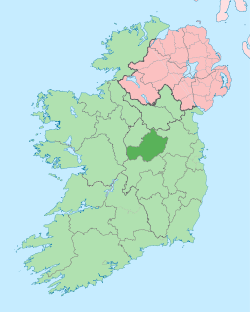Moate
| Moate An Móta | |
|---|---|
| Town | |
|
Main Street, Moate | |
 Moate Location in Ireland | |
| Coordinates: 53°23′44″N 7°43′14″W / 53.395434°N 7.720556°WCoordinates: 53°23′44″N 7°43′14″W / 53.395434°N 7.720556°W | |
| Country | Ireland |
| Province | Leinster |
| County | County Westmeath |
| Dáil Éireann | Westmeath |
| Elevation | 72 m (236 ft) |
| Population (2011)[1] | |
| • Total | 3,046 |
| Eircode | N37 |
| Irish Grid Reference | N182383 |
Moate (Irish: An Móta)[2] is a town in County Westmeath, Ireland.
The name An Móta is derived from the term motte-and-bailey, as the Normans built an example of this type of fortification here. The earthwork is still visible behind the buildings on the main street.
The town later became an important marketplace and Quaker village. There are several extant examples of Quaker houses on the main street, which itself is typical of an Irish marketplace.
Location
Moate is on the Cloghatanny River, also known as the Moate Stream, which is a tributary of the River Brosna. The confluence between the Cloghatanny and Brosna is 7.5 kilometres (4.7 mi) to the southeast of Moate, or 3 kilometres (1.9 mi) west of Clara.[3]
The town is on the R446 road between Kinnegad and Athlone. Before July 2008, this was the N6 road, a national primary route, and Moate was a serious traffic bottleneck. The new M6 motorway bypasses the town.
Amenities
Moate is a growing town with many new businesses including a supermarket, hardware store, an internet café-computer shop, pizzeria, petrol station, post office, gift shop, credit union, library, hair dresser, bank, sport shop, hotel and over twelve public houses. Many new building ventures have taken place in recent years including a complex of apartments and shops at the site of the old Convent of Mercy on Station Road.
Culture and heritage
The local Gaelic football club is the Moate All Whites. The club's name and playing kit colours are based on the white religious habits worn by the Carmelite White Friars, a long established Moate institution.
Moate Golf Club is situated in the centre of the town and boasts a fine 18 hole parkland course.
Moate has a strong musical tradition with many young bands emerging from the town. There is also a recording studio. Many ballad groups from the GAA clubs have won all ireland.
The town's theatre and arts centre is called Tuar Ard and was once the site of St. Patrick's Hall, which was a national school for a time. It is now a venue for plays, seminars, classical and rock concerts, and presentations.
The Dún na Sí heritage centre on the west side of town contains County Westmeath's genealogy centre, a restaurant, recreations of various types of indigenous dwellings, and preserved farm machinery.
The former gaol, part of the old courthouse, now contains a small museum housing artefacts found in the area dating from the Stone Age through to the modern era.
Transport
Bus
Bus Éireann and Irish Citylink operate Dublin–Galway bus routes that service Moate.[4][5]
Dublin to Galway Cycleway
The Mullingar (West) to Garrycastle (Athlone East) section of the Dublin-Galway Greenway (cycleway) was opened on the 3rd of October 2015 by An Taoiseach Enda Kenny In Moate.[6] The cycleway links Moate to Athlone and Mullingar on a 3m wide 40 km long cycleway.
The disused Moate railway station was built by the Midland Great Western Railway to connect Dublin and Galway and opened on 1 August 1851. It closed for goods traffic on 2 December 1974, and closed for passenger traffic on 27 January 1987.[7] Parts of the film The First Great Train Robbery (1979)[8] were filmed on the local railway. The train station depicted as "Ashford" is actually Moate Station.
Education
Moate has two primary schools: St. Brigid's Primary School on Station Road, formerly known as Convent Primary School, is co-educational and was founded by the Sisters of Mercy in 1861.[9] The other is St. Oliver Plunkett Boys' Primary School on Lake Road.
The town secondary school is Moate Community School on Church Street. A new building opened in the school in 2002 containing a gymnasium, four new science laboratories, a home economics room, art room, lecture hall, technical drawing classroom and an oratory as well as general classrooms and offices. It has approximately 1,000 students (including Moate Business College) and a staff of 72. Moate Business College, which is a PLC college, provides courses including performance arts and information technology.
Patrick Kelly Memorial Park
A memorial park opened in December 2008, named after the only Irish soldier to die in combat in Ireland since the end of the Irish Civil War. On 16 December 1983, Patrick Kelly, who was from Moate, was attempting to free American businessman Don Tidey, who had been kidnapped by the Irish Republican Army. Along with Garda recruit Gary Sheehan, he was killed in a shoot-out with IRA gunmen at Derrada Woods in Ballinamore, County Leitrim.[10]
Notable people
- Abraham Boulger, Victoria Cross recipient
- T.R. Dallas, singer
- Colm Murray, sports broadcaster
- Ray Lynam, country singer.
References
- ↑ AIRO/CSO PDR 2011 National Mapping Viewer All-Island Research Observatory. Retrieved: 2012-05-03.
- ↑ Moate Placenames Database of Ireland. Retrieved: 2012-12-30.
- ↑ Inspectors Report on a Waste Water Discharge Licence Application Environmental Protection Agency, 2010-05-27.
- ↑ Bus timetable: Dublin (and airport)–Galway route Bus Éireann. Retrieved: 2012-12-30.
- ↑ Bus timetable: Dublin (and airport)–Galway route City Link. Retrieved: 2012-12-30.
- ↑ Mullingar to Garrycastle Cycleway opening - Galway to Dublin Cycleway website, October 2015.
- ↑ "Moate station" (PDF). Railscot - Irish Railways. Retrieved 2007-11-04.
- ↑ Filming locations for The Great Train Robbery Internet Movie Database. Retrieved: 2012-12-30.
- ↑ St. Brigid's Primary School Retrieved: 2013-08-09.
- ↑ Town honours murdered soldier Irish Times, 2008-12-17.
External links
| Wikimedia Commons has media related to Moate. |
_-_geograph.org.uk_-_1606693.jpg)
